Multi-Source Data Analysis of Mesoscale Eddies and Their Effects on Surface Chlorophyll in the Bay of Bengal
Abstract
:1. Introduction
2. Materials and Methods
2.1. Materials
2.1.1. Satellite Data
2.1.2. Argo Float
2.2. Methods
2.2.1. Determine the Eddy Center
- (1)
- Along the east–west direction of the eddy center, the velocity component has opposite signs on both sides of the center point, and the magnitude gradually increases with the distance from the center point.
- (2)
- Along the north–south direction of the center of the eddy, the numerical signs of the velocity components on both sides of the center point are opposite, and the magnitude gradually increases with the distance from the center point. The direction of change considered is consistent with the direction of change of and .
- (3)
- In the local region of the eddy center, the velocity has the minimum value.
- (4)
- Around the eddy center, the rotation properties of the eddy velocity vector change are consistent.
2.2.2. Extract the Eddy Boundary
2.2.3. Track the Eddy Lifespan
3. Results
3.1. Eddy Statistical Analysis
3.1.1. Eddy Spatiotemporal Distributions, Sizes and Lifespan
3.1.2. Eddy Vorticity, Strain, and Evolution
3.1.3. Eddy Generation and Dissipation
3.1.4. Eddy Movement and Propagation
3.2. Eddy Impact on Temperature/Salinity (T/S)
3.3. Abnormal Eddies
3.4. Effect of Eddy on Sea Surface Chlorophyll (Chl)
4. Discussion
4.1. The Mechanisms for Eddy Generation and Dissipation
4.2. Chl Rings
5. Conclusions
Author Contributions
Funding
Acknowledgments
Conflicts of Interest
References
- Wang, H.; Liu, D.; Zhang, W.; Li, J.; Wang, B. Characterizing the Capability of Mesoscale Eddies to Carry Drifters in the Northwest Pacific. J. Oceanol. Limnol. 2020, 1–18. [Google Scholar] [CrossRef]
- Stammer, D. On Eddy Characteristics, Eddy Transports, and Mean Flow Properties. J. Phys. Oceanogr. 1998, 28, 727–739. [Google Scholar] [CrossRef]
- Qiu, B.; Chen, S. Eddy-Induced Heat Transport in the Subtropical North Pacific from Argo, TMI, and Altimetry Measurements. J. Phys. Oceanogr. 2005, 35, 458–473. [Google Scholar] [CrossRef]
- Gaube, P.; Mcgillicuddy, D.J.; Chelton, D.B.; Behrenfeld, M.J.; Strutton, P.G. Regional Variations in the Influence of Mesoscale Eddies on Near-surface Chlorophyll. J. Geophys. Res. 2014, 119, 8195–8220. [Google Scholar] [CrossRef] [Green Version]
- Holland, W.R.; William, R. The Role of Mesoscale Eddies in the General Circulation of the Oceannumerical Experiments using a Wind-driven Quasi-geostrophic Model. J. Phys. Oceanogr. 1978, 8, 363–392. [Google Scholar] [CrossRef] [Green Version]
- McWilliams, J.C.; Flierl, G.R. On the Evolution of Isolated Non-linear Vortices. J. Phys. Oceanogr. 1979, 9, 1155–1182. [Google Scholar] [CrossRef]
- Chelton, D.B.; Schlax, M.C.; Samelson, R.M.; Szoeke, R.A.D. Global Observations of Large Oceanic Eddies. Geophys. Res. Lett. 2007, 34, L15606. [Google Scholar] [CrossRef]
- Chelton, D.B.; Schlax, M.G.; Samelson, R.M. Global Observations of Nonlinear Mesoscale Eddies. Progr. Oceanogr. 2011, 91, 167–216. [Google Scholar] [CrossRef]
- Gruber, N.; Lachkar, Z.; Frenzel, H.; Marchesiello, P.; Plattner, G.K. Eddy-induced Reduction of Biological Production in Eastern Boundary Upwelling Systems. Nat. Geosci. 2011, 4, 787–792. [Google Scholar] [CrossRef]
- Dong, C.; Mcwilliams, J.C.; Liu, Y.; Chen, D. Global Heat and Salt Transports by Eddy Movement. Nat. Commun. 2014, 5, 3294. [Google Scholar] [CrossRef] [Green Version]
- Petersen, M.R.; Williams, S.J.; Maltrud, M.E.; Hecht, M.W.; Hamann, B. A Three-dimensional Eddy Census of a High-resolution Global Ocean Simulation. J. Geophys. Res. 2013, 118, 1759–1774. [Google Scholar] [CrossRef]
- Sun, W.; Dong, C.; Wang, R.; Liu, Y.; Yu, K. Vertical Structure Anomalies of Oceanic Eddies in the Kuroshio Extension region. J. Geophys. Res. 2017, 122, 1476–1496. [Google Scholar] [CrossRef]
- Yoshida, K. A Theory of the Cromwell Current (the equatorial undercurrent) and of the Equatorial upwelling-An Interpretation in a Similarity to a Coastal Circulation. J. Oceanogr. Soc. Jpn. 1959, 15, 159–170. [Google Scholar] [CrossRef] [Green Version]
- Wyrtki, K. An Equatorial Jet in the Indian Ocean. Science 1973, 181, 262–264. [Google Scholar] [CrossRef]
- Iskandar, I.; Michael, J.M. Dynamics of Wind-forced Intraseasonal Zonal Current Variations in the Equatorial Indian Ocean. J. Geophys. Res. 2011, 116, C06019. [Google Scholar] [CrossRef] [Green Version]
- Goswami, B.N.; Rao, S.A.; Sengupta, D.; Chakravorty, S. Monsoons to Mixing in the Bay of Bengal: Multiscale Air-sea Interactions and Monsoon Predictability. Oceanography 2016, 29, 18–27. [Google Scholar] [CrossRef] [Green Version]
- Babu, M.T.; Kumar, P.S.; Rao, D.P. A Subsurface Cyclonic Eddy in the Bay of Bengal. J. Mar. Res. 1991, 49, 403–410. [Google Scholar] [CrossRef]
- Sanilkumar, K.V.; Kuruvilla, T.V.; Jogendranath, D.; Rao, R.R. Observations of the Western Boundary Current of the Bay of Bengal from a Hydrographic Survey during March 1993. Deep Sea Res. 1997, 44, 1–145. [Google Scholar] [CrossRef]
- Sarma, Y.V.B.; Rao, E.P.R.; Saji, P.K.; Sarma, V.V.S.S. Hydrography and Circulation of the Bay of Bengal During withdrawal Phase of the Southwest Monsoon. Oceanologica Acta. 1999, 22, 453–471. [Google Scholar] [CrossRef] [Green Version]
- Eigenheer, A.; Quadfasel, D. Seasonal Variability of the Bay of Bengal Circulation from TOPEX/Poseiden Altimetry. J. Geophys. Res. 2000, 105, 3243–3252. [Google Scholar] [CrossRef]
- Chen, G.; Wang, D.; Hou, Y. The Features and Interannual Variability Mechanism of Mesoscale Eddies in the Bay of Bengal. Cont. Shelf Res. 2012, 47, 178–185. [Google Scholar] [CrossRef]
- Cheng, X.; Xie, S.P.; Mccreary, J.P.; Qi, Y.; Du, Y. Intraseasonal Variability of Sea Surface Height in the Bay of Bengal. J. Geophys. Res. 2013, 118, 816–830. [Google Scholar] [CrossRef]
- Cui, W.; Yang, J.; Ma, Y. A Statistical Analysis of Mesoscale Eddies in the Bay of Bengal from 22–year Altimetry Data. Acta Oceanol. Sin. 2016, 35, 16–27. [Google Scholar] [CrossRef]
- Dandpat, S.; Chakraborty, A. Mesoscale Eddies in the Western Bay of Bengal as Observed from Satellite Altimetry in 1993–2014: Statistical Characteristics, Variability and Three-dimensional Properties. IEEE J-STARS 2017, 9, 5044–5054. [Google Scholar] [CrossRef]
- Chang, J.; Qiu, Y.; Lin, X.; Jing, C. General Features and Seasonal Variation of Mesoscale Eddies in the Bay of Bengal. J. Appl. Oceanogr. 2019, 38, 150–158. (In Chinese) [Google Scholar] [CrossRef]
- Babin, S.M.; Carton, J.; Wiggert, J.D. Satellite Evidence of Hurricane-induced Phytoplankton Blooms in an Oceanic Desert. J Geophys. Res. 2004, 109, 325–347. [Google Scholar] [CrossRef]
- Longhurst, A.; Sathyendranath, S.; Platt, T.; Caverhill, C. An Estimate of Global Primary Production in the Ocean from Satellite Radiometer Data. J. Plankton Res. 1995, 17, 1245–1271. [Google Scholar] [CrossRef] [Green Version]
- Antoine, D.; Andre, J.M.; Morel, A. Oceanic Primary Production: 2. Estimation at Global Scale from Satellite (coastal zone color scanner) Chlorophyll. Global Biogeochem. Cycles 1996, 10, 57–69. [Google Scholar] [CrossRef]
- Field, C.B.; Behrenfeld, M.J.; Randerson, J.T.; Falkowski, P. Primary Production of the Biosphere: Integrating Terrestrial and Oceanic Components. Science 1998, 281, 237–240. [Google Scholar] [CrossRef] [Green Version]
- McGillicuddy, D.J.; Robinson, A.R.; McCarthy, J.J. Coupled Physical and Biological Modelling of the Spring Bloom in the North Atlantic (II): Three dimensional Bloom and Post-bloom Processes. Deep Sea Res. 1995, 42, 1359–1398. [Google Scholar] [CrossRef]
- Martin, A.P.; Richards, K.J. Mechanisms for Vertical Nutrient Transport within a North Atlantic Mesoscale Eddy. Deep Sea Res. 2001, 757–773. [Google Scholar] [CrossRef]
- Rafael, G.Q.; Pascual, A.; Damiá, G.; Ricardo, A. Influence of Mesoscale Physical Forcing on Trophic Pathways and Fish Larvae Retention in the Central Cantabrian Sea. Fish. Oceanogr. 2004, 13, 351–364. [Google Scholar] [CrossRef]
- Falkowski, P.G.; Ziemann, D.; Kolber, Z.; Bienfang, P.K. Role of Eddy Pumping in Enhancing Primary Production in the Ocean. Nature 1991, 352, 55–58. [Google Scholar] [CrossRef]
- Oschlies, A.; Garcon, V. Eddy-induced Enhancement of Primary Production in a Model of the North Atlantic Ocean. Nature 1998, 394, 266–269. [Google Scholar] [CrossRef]
- Letelier, R.M.; Karl, D.M.; Abbott, M.R.; Flament, P.; Freilich, M.; Lukas, R. Role of Late Winter Mesoscale Events in the Biogeochemical Variability of the Upper Water Column of the North Pacific Subtropical Gyre. J. Geophys. Res. 2000, 105, 28723–28739. [Google Scholar] [CrossRef]
- Oschlies, A. Nutrient Supply to the Surface Waters of the North Atlantic: A Model Study. J. Geophys. Res. 2002, 107, 1–13. [Google Scholar] [CrossRef]
- Mcgillicuddy, D.J.; Anderson, L.A.; Doney, S.C.; Maltrud, M.E. Eddy-driven Sources and Sinks of Nutrients in the Upper Ocean: Results from a 0.1°Resolution Model of the Noth Atlantic. Glob. Biogeochem. Cycles 2003, 17, 1035. [Google Scholar] [CrossRef]
- Murtugudde, R.G.; McCreary, J.P.; Busalacchi, A.J. Oceanic Processes Associated with Anomalous Events in the Indian Ocean with Relevance to 1997–1998. J. Geophys. Res. 2000, 105, 3295–3306. [Google Scholar] [CrossRef] [Green Version]
- Vinayachandran, P.N. Observations of Barrier Layer Formation in the Bay of Bengal during Summer Monsoon. J. Geophys. Res. 2002, 107, 8018. [Google Scholar] [CrossRef]
- Kumar, P.S.; Nuncio, M.; Narvekar, J.; Kumar, A.; Sardesai, S.; De Souza, S.N.; Mangesh, G.; Ramaiah, N.; Madhupratap, M. Are Eddies Nature’s Trigger to Enhance Biological Productivity in the Bay of Bengal? Geophys. Res. Lett. 2004, 31. [Google Scholar] [CrossRef] [Green Version]
- Kumar, P.S.; Nuncio, M.; Ramaiah, N.; Sardesai, S.; Narvekar, J.; Fernandes, V.; Paul, J. Eddy-mediated Biological Productivity in the Bay of Bengal during Fall and Spring Intermonsoons. Deep Sea Res. 2007, 54, 1619–1640. [Google Scholar] [CrossRef] [Green Version]
- Chelton, D.B.; Gaube, P.; Schlax, M.G.; Early, J.J.; Samelson, R.M. The Influence of Nonlinear Mesoscale Eddies on Near-surface Oceanic Chlorophyll. Science 2011, 334, 328–332. [Google Scholar] [CrossRef] [PubMed]
- Singh, A.; Gandhi, N.; Ramesh, R.; Prakash, S. Role of Cyclonic Eddy in Enhancing Primary and New Production in the Bay of Bengal. J. Sea. Res. 2015, 97, 5–13. [Google Scholar] [CrossRef]
- Gonaduwage, L.P.; Chen, G.; Michael, J.; Priyadarshana, T.; Huang, K.; Wang, D. Meridional and Zonal Eddy-induced Heat and Salt Transport in the Bay of Bengal and their Seasonal Modulation. J. Geophys. Res. 2019, 124, 8079–8101. [Google Scholar] [CrossRef]
- Kumar, P.S.; Muraleedharan, P.M.; Prasad, T.G.; Gauns, M.; Ramaiah, N.; de Souza, S.N.; Sardesai, S.; Madhupratap, M. Why is the Bay of Bengal Less Productive during Summer Monsoon Compared to the Arabian Sea? Geophys. Res. Lett. 2002, 29, 1–4. [Google Scholar] [CrossRef] [Green Version]
- Nencioli, F.; Dong, C.; Dickey, T.; Washburn, L.; Mcwilliams, J.C. A Vector Geometry Based Eddy Detection Algorithm and its Application to High-resolution Numerical Model Products and High-frequency Radar Surface Velocities in the Southern California Bight. J. Atmos. Ocean. Technol. 2010, 27, 564–579. [Google Scholar] [CrossRef]
- Sun, W.; Dong, C.; Tan, W.; Liu, Y.; He, Y.; Wang, J. Vertical Structure Anomalies of Oceanic Eddies and Eddy-induced Transports in the South China Sea. Remote Sens. 2018, 10, 795. [Google Scholar] [CrossRef] [Green Version]
- Sun, W.; Dong, C.; Tan, W.; He, Y. Statistical Characteristics of Cyclonic Warm-Core Eddies and Anticyclonic Cold-core Eddies in the North Pacific Based on Remote Sensing Data. Remote Sens. 2019, 11, 208. [Google Scholar] [CrossRef] [Green Version]
- Liu, Y.; Dong, C.; Liu, X.; Dong, J. Antisymmetry of Oceanic Eddies across the Kuroshio over a Shelfbreak. Sci. Rep. 2017, 7, 6761. [Google Scholar] [CrossRef] [Green Version]
- Lin, X.; Dong, C.; Chen, D.; Liu, Y.; Yang, J.; Zou, B. Three-dimensional Properties of Mesoscale Eddies in the South China Sea Based on Eddy-resolving Model Output. Deep Sea Res. 2015, 99, 46–64. [Google Scholar] [CrossRef]
- Amores, A.; Monserrat, S.; Marcos, M. Vertical Structure and Temporal Evolution of an Anticyclonic Eddy in the Balearic Sea (western Mediterranean). J. Geophys. Res. 2013, 118, 2097–2106. [Google Scholar] [CrossRef] [Green Version]
- Dong, C.; Mavor, T.; Nencioli, F.; Jiang, S.; Uchiyama, Y.; Mcwilliams, J.C.; Dickey, T.; Ondrusek, M.; Zhang, H.; Clark, D.K. An Oceanic Cyclonic Eddy on the Lee Side of Lanai Island, Hawai’i. J. Geophys. Res. 2009, 114, C10008. [Google Scholar] [CrossRef] [Green Version]
- Wen, Z.; Hu, H.; Zhang, N.; Lei, L.; Bai, H. Different Influences of Mesoscale Oceanic Eddies on the North Pacific Subsurface Low Potential Vorticity Water Mass between Winter and Summer. J. Geophys. Res. 2020, 125. [Google Scholar] [CrossRef] [Green Version]
- Jiménez-Muñoz, J.C.; Mattar, C.; Barichivich, J.; Santamaría-Artigas, A.; Takahashi, K.; Malhi, Y.; Sobrino, J.A.; Van Der Schrier, G. Record-breaking Warming and Extreme Drought in the Amazon Rainforest during the Course of El Niño 2015–2016. Sci. Rep. 2016, 6, 33130. [Google Scholar] [CrossRef] [Green Version]
- Qiu, Y.; Li, L.; Zhou, X. Sir Lanka Code Eddy and its Generation Mechanism Analysis. J. Top. Ocean Graphy 2008, 27, 45–51. (In Chinese) [Google Scholar] [CrossRef]
- Roman-Stork, H.L.; Subrahmanyam, B.; Trott, C.B. Mesoscale Eddy Variability and its Linkage to Deep Convection over the Bay of Bengal using Satellite Altimetric Observations. Adv. Space Res. 2019. [Google Scholar] [CrossRef]
- Sang, P.; Pascual, A.; Rodriguez-Santana, A.; Machin, F.; Mason, E.; McWilliams, J.; Pelegri, J.; Dong, C.; Rubio, A.; Aristegui, J.; et al. Canary Eddy Corridor: A Majorpathway for Long-lived Eddies in the Subtropic North Atlantic Ocean. Deep Sea Res. 2009, 8, 2100–2114. [Google Scholar] [CrossRef]
- Liu, Y.; Dong, C.; Guan, Y.; Chen, D.; McWilliams, J.C.; Nencioli, F. Eddy Analysis in the Subtropical Zonal Band of the North Pacific Ocean. Deep Sea Res. 2012, 68, 54–67. [Google Scholar] [CrossRef]
- Ji, J.; Dong, C.; Zhang, B.; Liu, Y. An Oceanic eddy Statistical Comparison using Multiple Observational Data in the Kuroshio Extension Region. Acta Oceanol. Sin. 2017, 36, 1–7. [Google Scholar] [CrossRef]
- Qin, D.; Wang, J.; Liu, Y.; Dong, C. Eddy Analysis in the Eastern China Sea using Altimetry Data Frontiers of Earth Science. Front. Earth Sci. 2015, 9, 709–721. [Google Scholar] [CrossRef]
- Dong, C.; McWilliams, J.C. A Numerical Study of Island Wakes in the Southern California Bight. Cont. Shelf Res. 2007, 27, 1233–1248. [Google Scholar] [CrossRef]
- Xu, G.; Dong, C.; Liu, Y.; Gaube, P.; Yang, J. Chlorophyll Rings around Ocean Eddies in the North Pacific. Sci. Rep. 2019, 9, 9. [Google Scholar] [CrossRef] [PubMed] [Green Version]
- Sabu, P.; Devi, C.R.A.; Lathika, C.T.; Sanjeevan, V.N.; Gupta, G.V.M. Characteristics of a Cyclonic Eddy and its Influence on Mesozooplankton Community in the Northern Bay of Bengal during Early Winter Monsoon. Environ. Monit. Assess. 2015, 187, 1–19. [Google Scholar] [CrossRef] [PubMed]
- Vinayachandran, P.N.; Masumoto, Y.; Mikawa, T.; Yamagata, T. Intrusion of the Southwest Monsoon Current into the Bay of Bengal. J. Geophys. Res. 1999, 104, 11077–11085. [Google Scholar] [CrossRef]
- Schott, F.A.; Mccreary, J.P. The Monsoon Circulation of the Indian Ocean. Prog. Oceanogr. 2001, 51, 1–123. [Google Scholar] [CrossRef]
- Zhai, X.; Johnson, H.L.; Marshall, D.P. Significant Sink of Ocean-eddy Energy near Western Boundaries. Nat. Geosci. 2010, 608–612. [Google Scholar] [CrossRef]
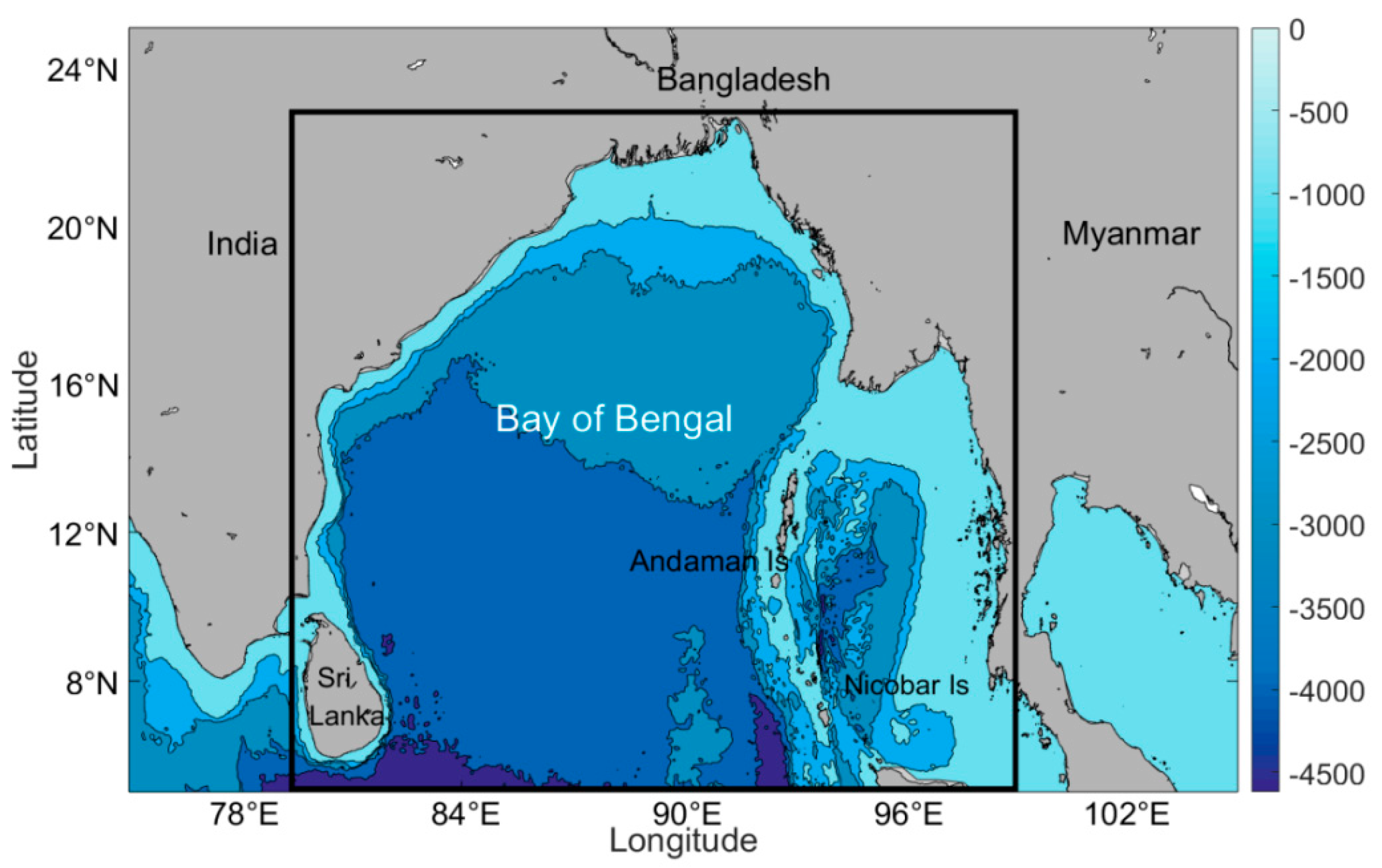
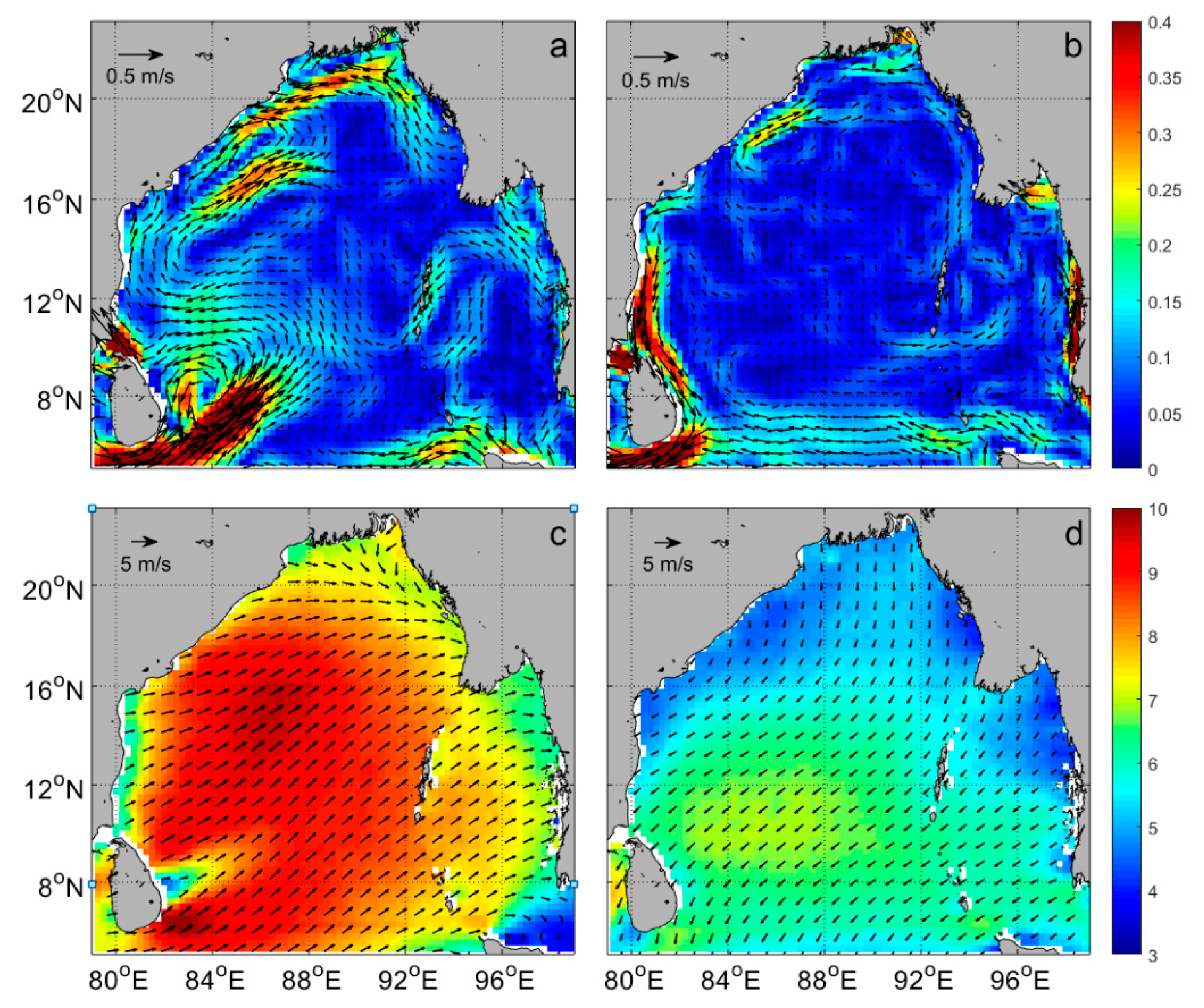
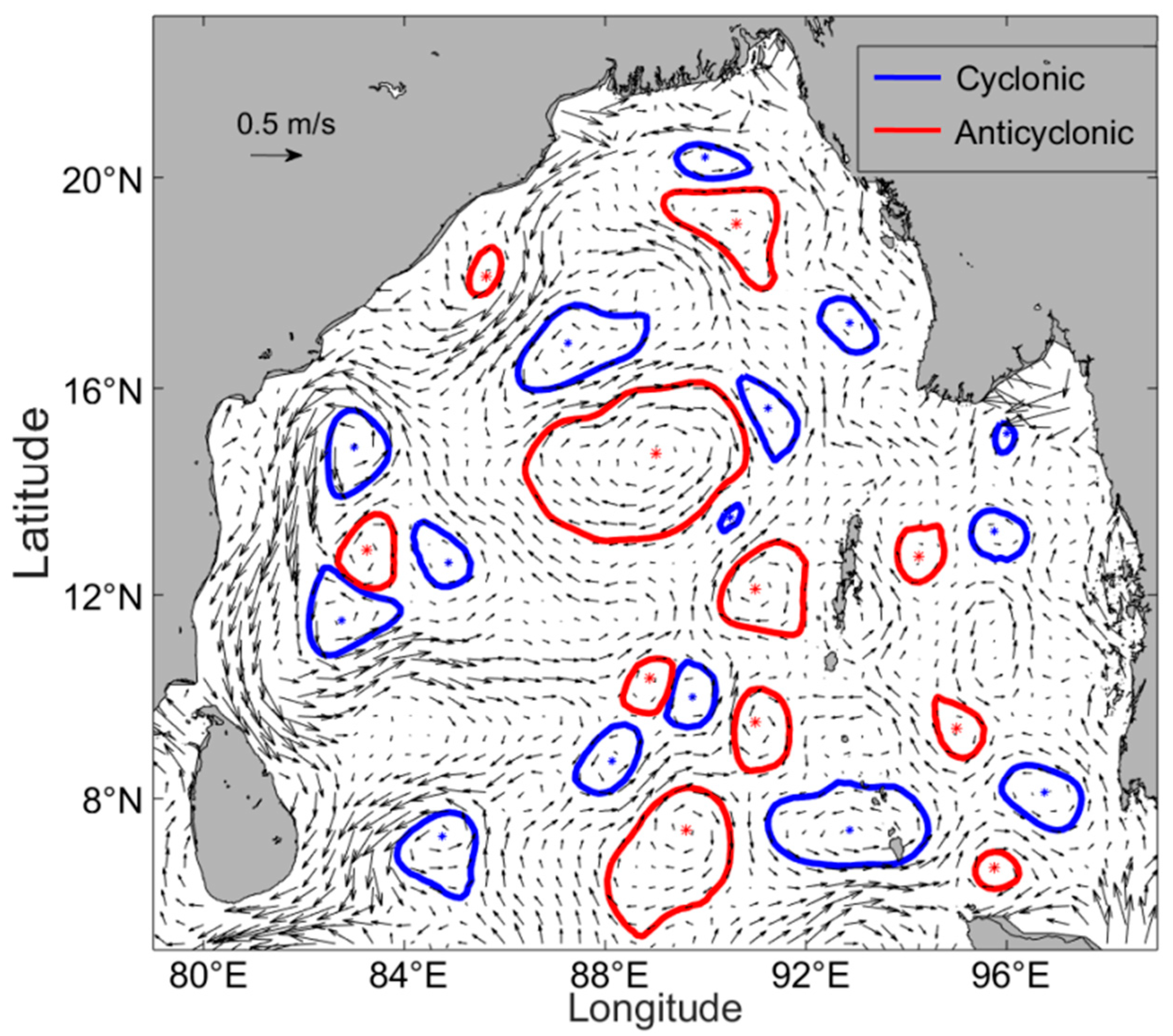

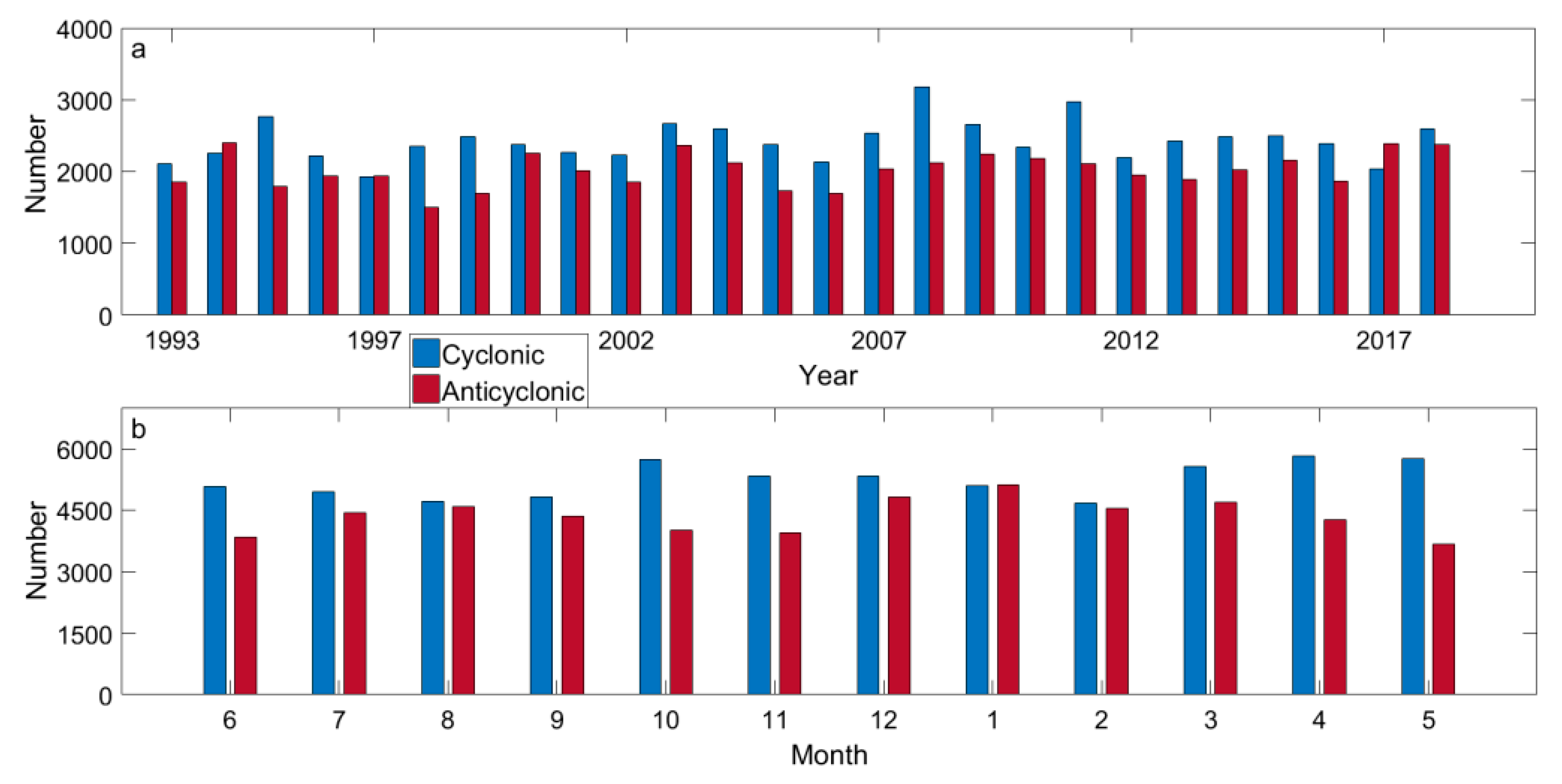

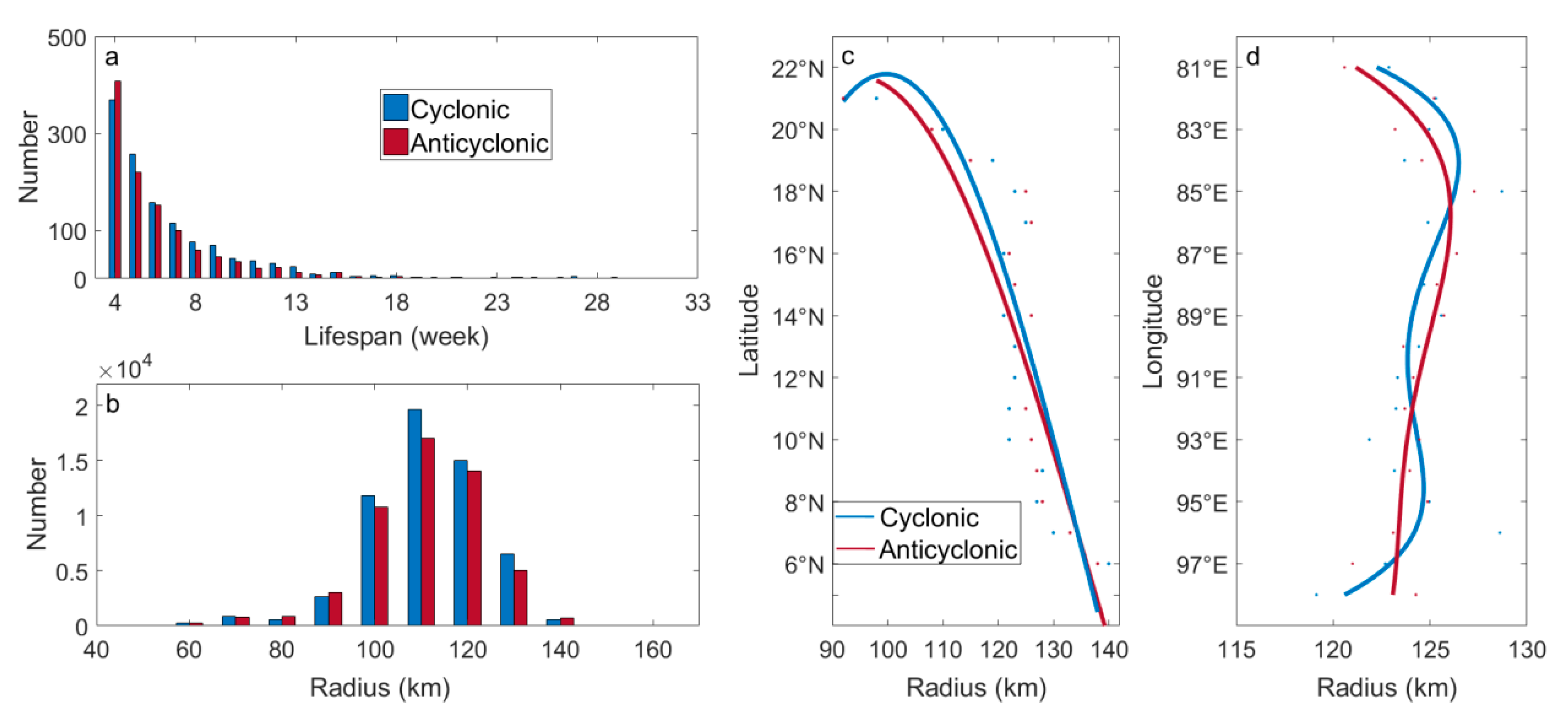
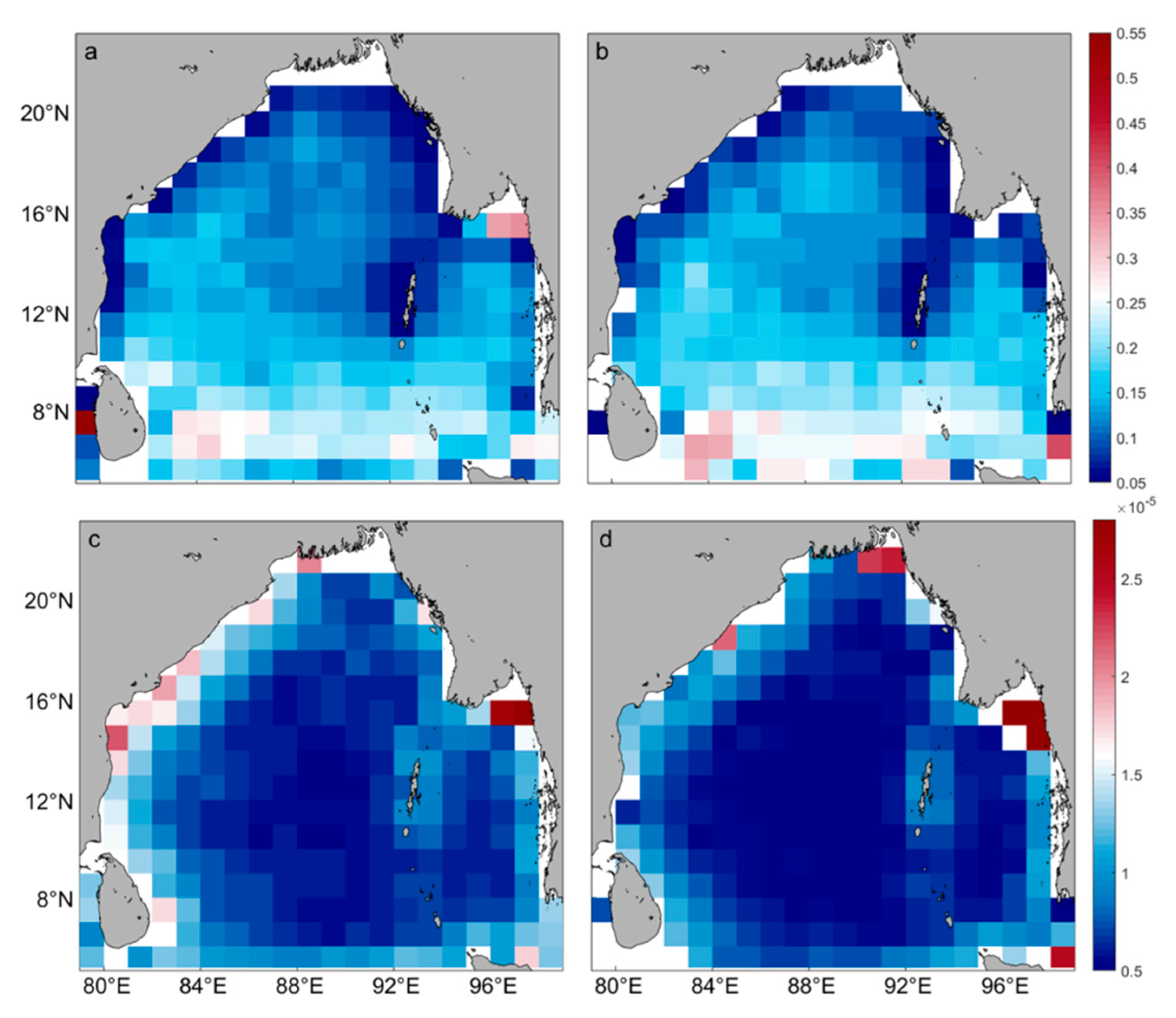
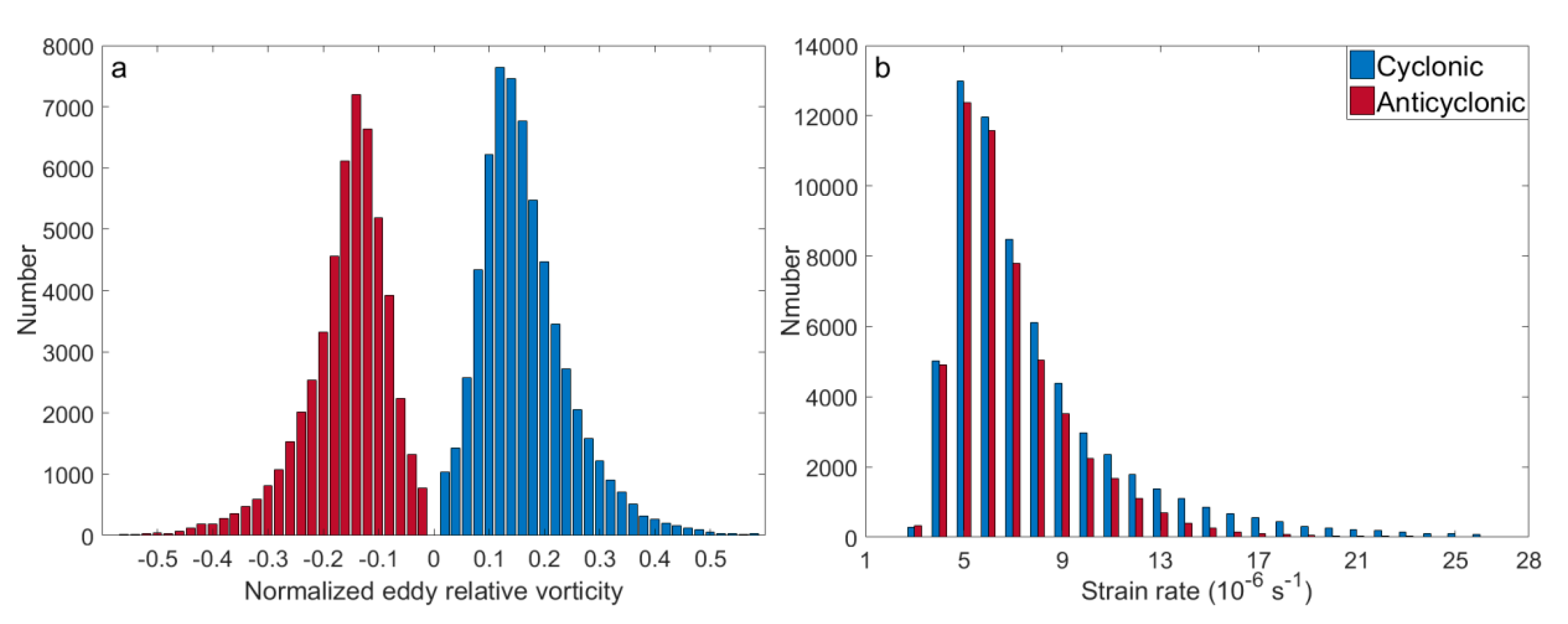


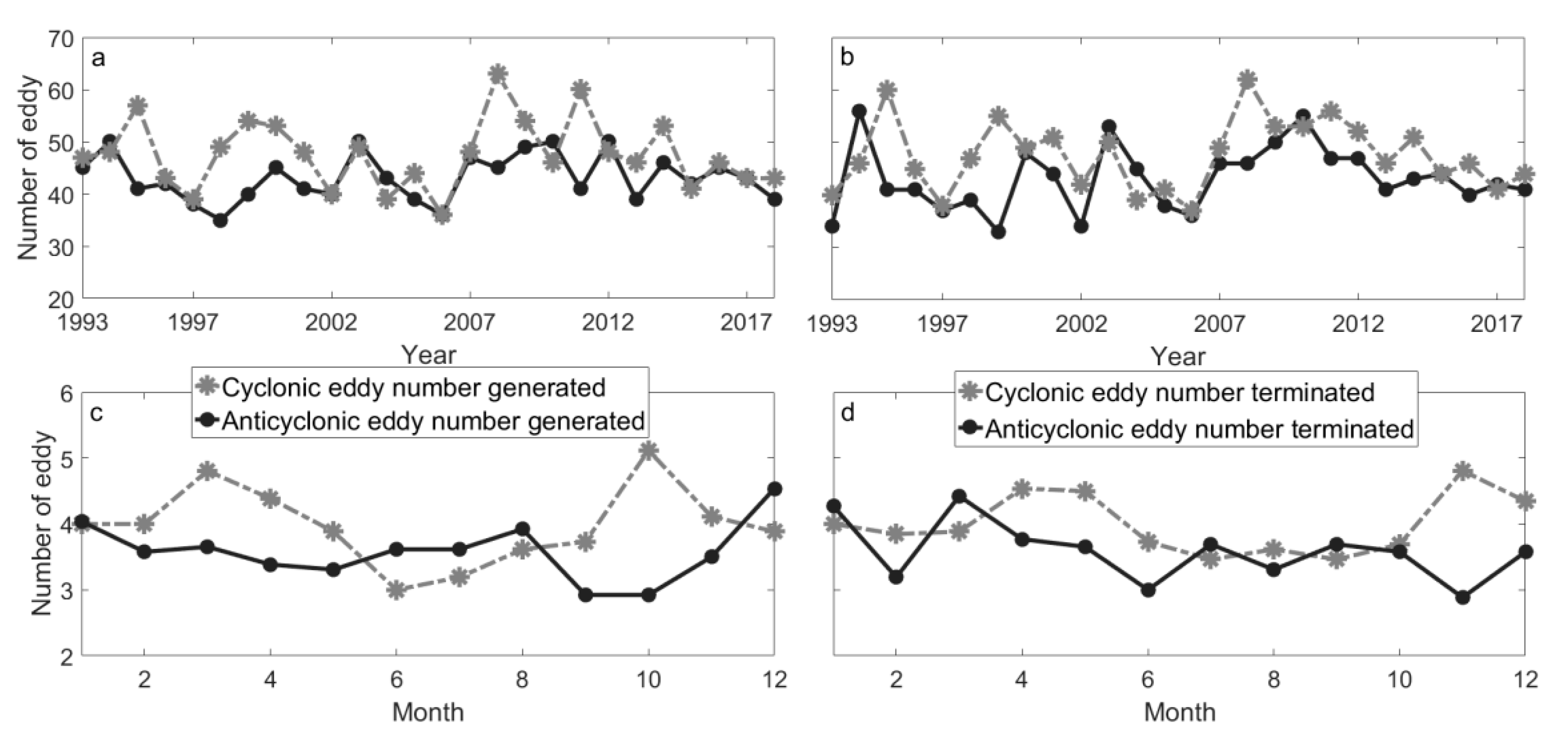

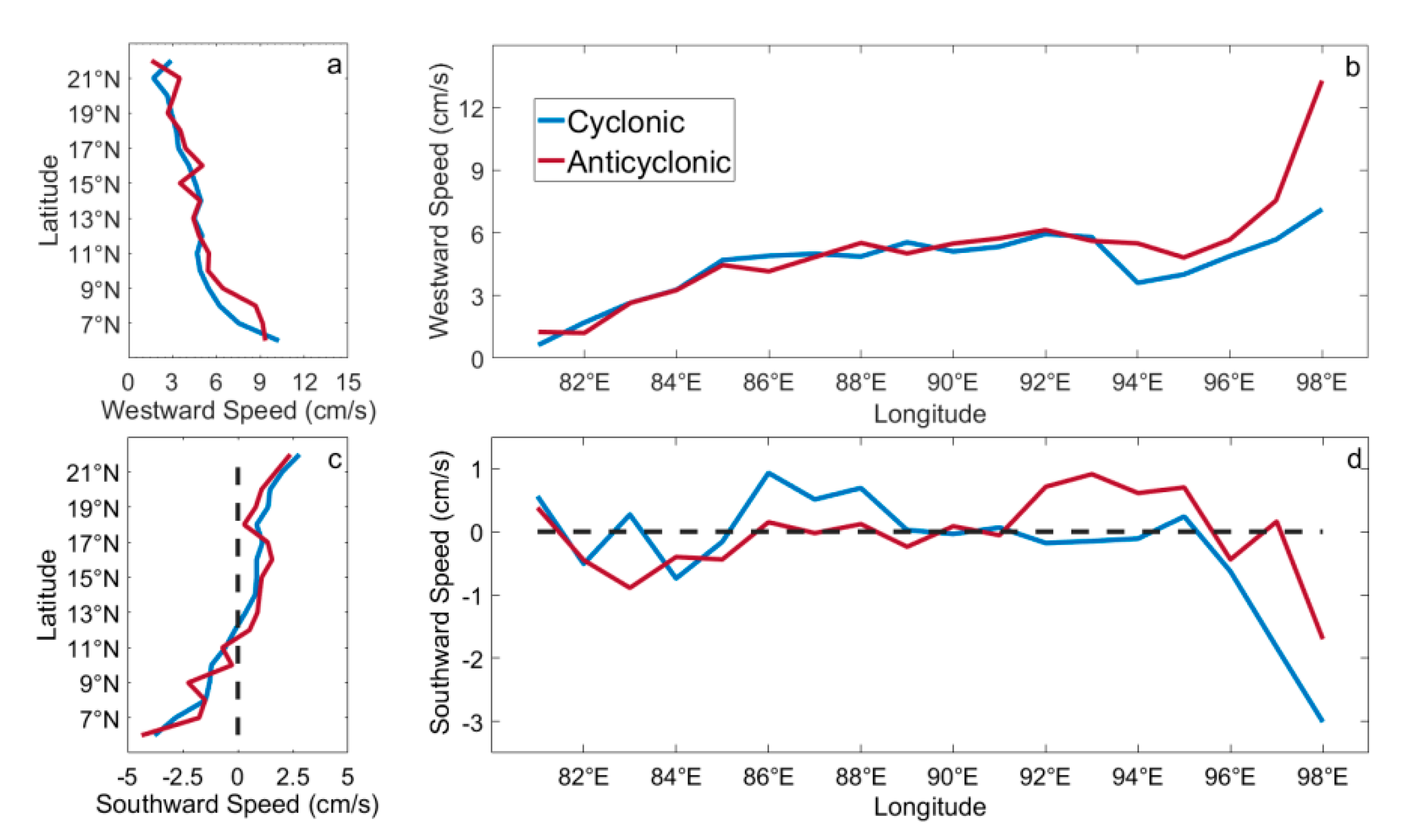
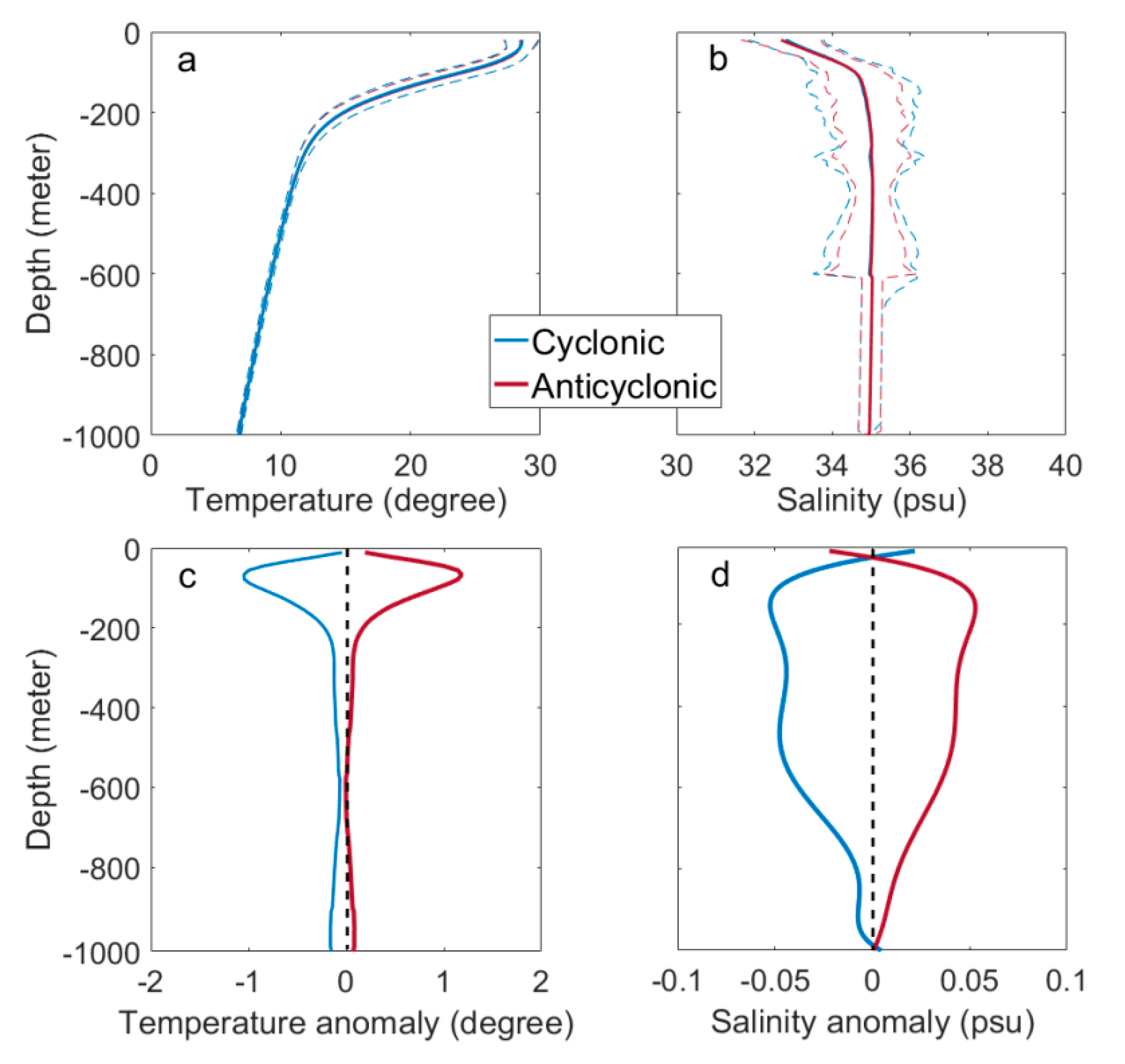
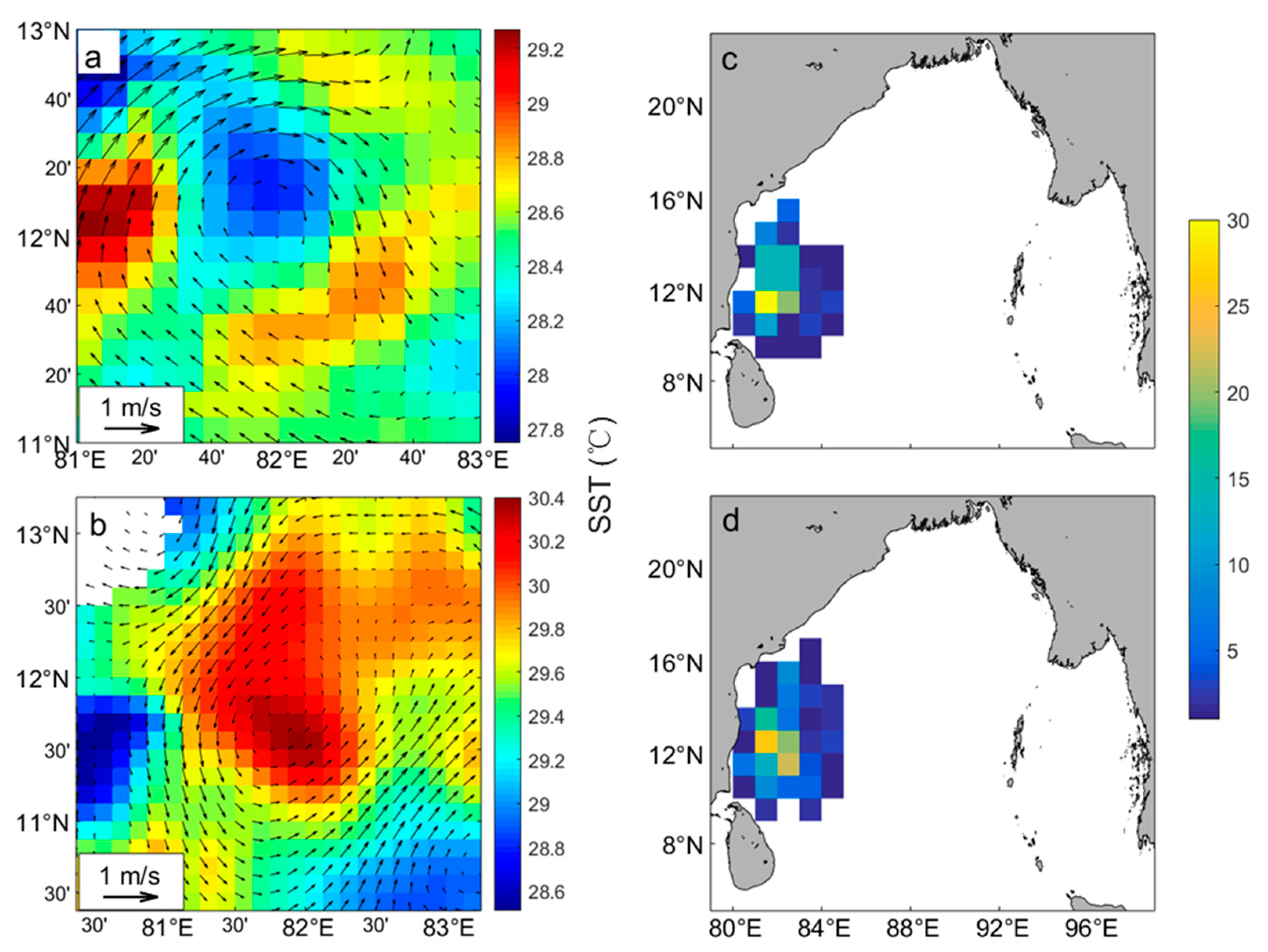
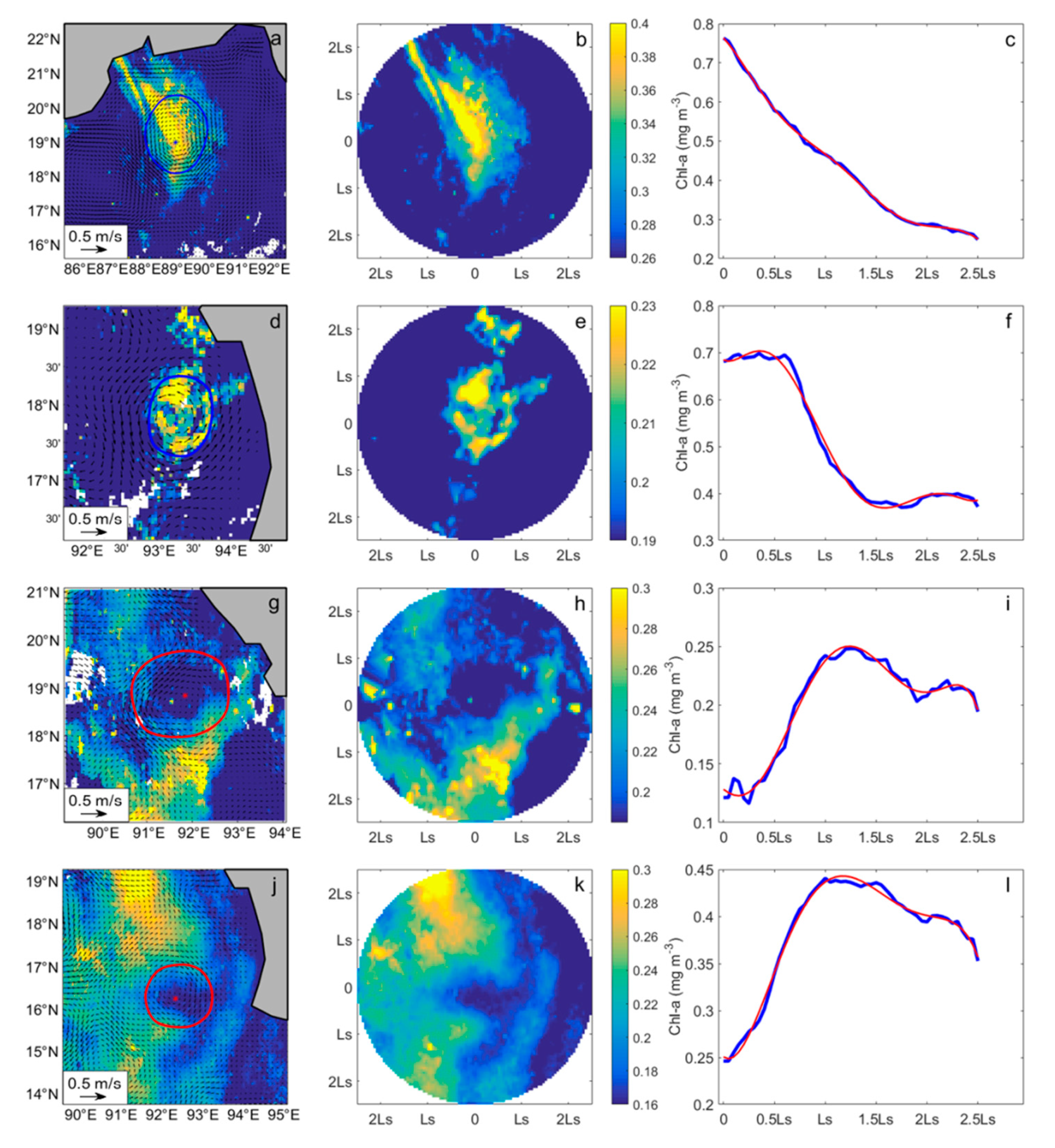
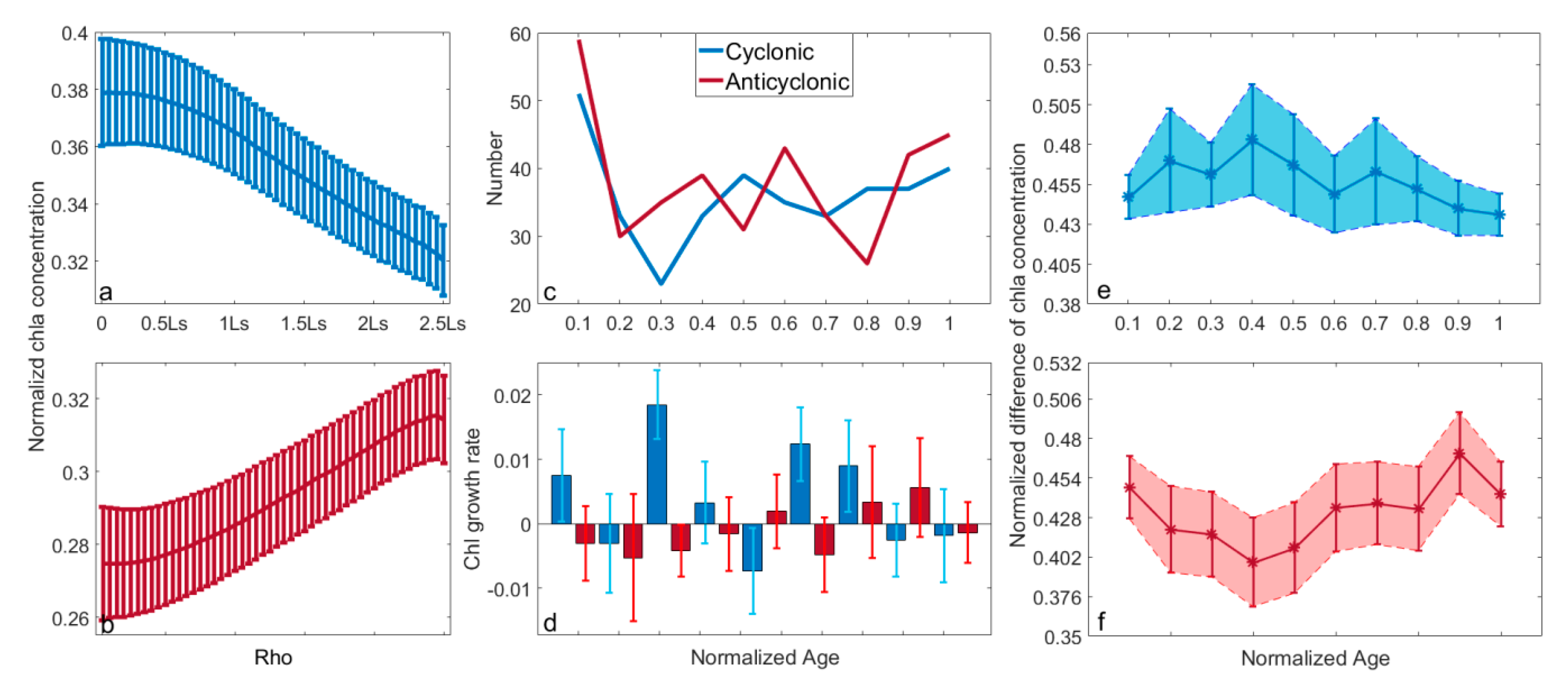
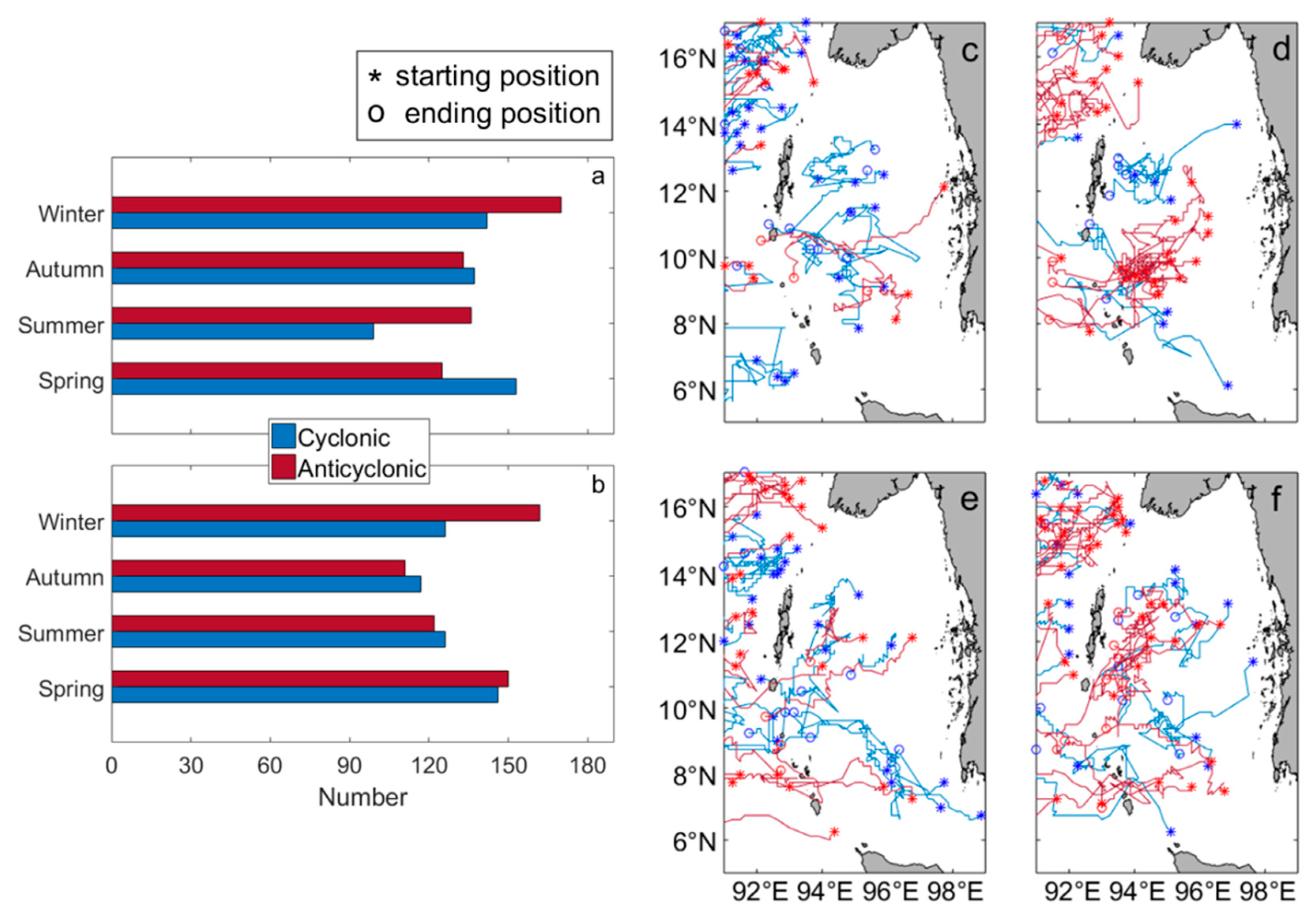


| Lifespan (Days) | Eddy-Counting Methods | Eddy | CE | AE |
|---|---|---|---|---|
| Lagrangian | 11,730 | 5924 | 5788 | |
| Eulerian | 287,365 | 149,229 | 138,136 | |
| Lagrangian | 2358 | 1237 | 1121 | |
| Eulerian | 110,524 | 58,037 | 52,487 |
Publisher’s Note: MDPI stays neutral with regard to jurisdictional claims in published maps and institutional affiliations. |
© 2020 by the authors. Licensee MDPI, Basel, Switzerland. This article is an open access article distributed under the terms and conditions of the Creative Commons Attribution (CC BY) license (http://creativecommons.org/licenses/by/4.0/).
Share and Cite
Yang, X.; Xu, G.; Liu, Y.; Sun, W.; Xia, C.; Dong, C. Multi-Source Data Analysis of Mesoscale Eddies and Their Effects on Surface Chlorophyll in the Bay of Bengal. Remote Sens. 2020, 12, 3485. https://doi.org/10.3390/rs12213485
Yang X, Xu G, Liu Y, Sun W, Xia C, Dong C. Multi-Source Data Analysis of Mesoscale Eddies and Their Effects on Surface Chlorophyll in the Bay of Bengal. Remote Sensing. 2020; 12(21):3485. https://doi.org/10.3390/rs12213485
Chicago/Turabian StyleYang, Xiao, Guangjun Xu, Yu Liu, Wenjin Sun, Changshui Xia, and Changming Dong. 2020. "Multi-Source Data Analysis of Mesoscale Eddies and Their Effects on Surface Chlorophyll in the Bay of Bengal" Remote Sensing 12, no. 21: 3485. https://doi.org/10.3390/rs12213485






